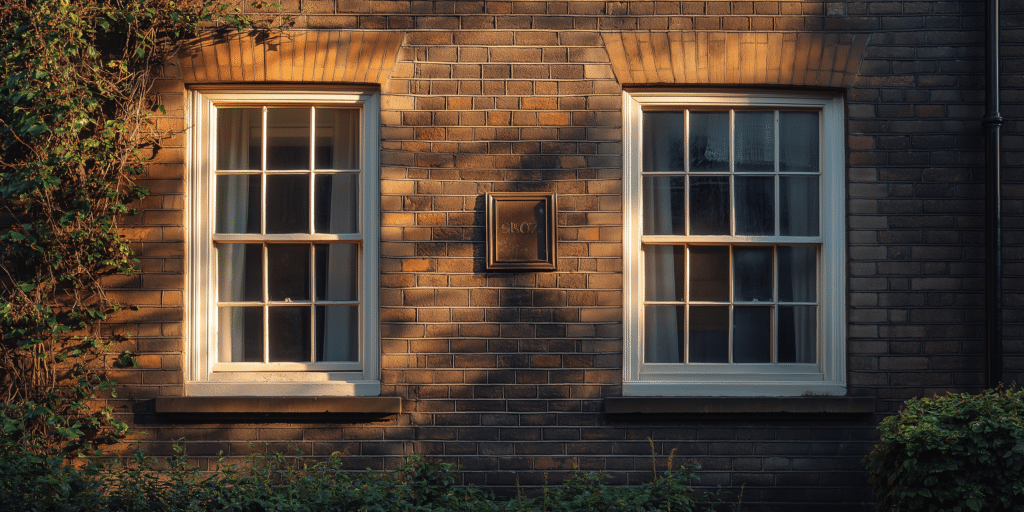What is a Sash Window Thermal Break?

A thermal break in a sash window functions as a crucial layer of insulation, often an essential element for improving energy efficiency. You might wonder, how does this thermal break work? The thermal break disrupts heat transfer across the window’s aluminium or timber frame by integrating an insulating material such as polyamide or polyurethane between the interior and exterior frame surfaces.
This barrier can reduce heat loss by as much as 30-40%, maintaining indoor warmth in winter while preventing excessive heat ingress during summer. The reduced heat transfer and insulation not only aids in temperature regulation but also aligns with modern British energy efficiency standards, reducing the overall U-value and improving the building’s energy performance certificate (EPC) rating.
Why Are Thermal Breaks Important for Sash Windows?
Traditional sash windows, widely valued for their heritage aesthetics, often struggle with poor thermal performance. Due to the conductive properties of metal and wood materials permit substantial heat exchange without a thermal break. Thermal breaks can reduce this heat transfer by up to 40%, aligning sash windows with the latest Part L Building Regulations for energy efficiency.
Such integration makes sash windows functionally competitive with modern, energy-efficient window types without compromising heritage properties’ historical charm and aesthetic integrity. Thermally broken windows maintain consistent indoor temperatures and reduce energy use.
How Does a Thermal Break Work Within a Sash Window?
Thermal breaks rely on non-conductive materials to form a “broken bridge” that stops heat conduction between a window’s interior and exterior surfaces. Most commonly, these are made from polyamide or EPDM rubber, chosen for their durability and low thermal conductivity.
This structural component, placed within the sash or frame profile, disrupts the heat flow path, translating to warmer indoor frames in colder months and significantly reducing condensation buildup. Incorporating this type of insulation can help sash windows achieve U-values as low as 1.6 W/m²K, a significant improvement over the 5.0 W/m²K of single-pane sash windows, enhancing the home’s overall thermal comfort and insulation.
What Materials Are Best for Thermal Breaks in Sash Windows?

Polyamide, polyurethane, and thermal plastic insulators are favoured for thermal breaks due to their durability and minimal thermal conductivity. These materials effectively separate the sash frame and glass pane, ensuring heat does not quickly transfer through the frame.
Polyamide strips, in particular, are durable, structurally sound, and maintain the window’s aesthetic integrity. High-quality sash windows with polyamide or thermal plastic breaks deliver optimal insulation, essential for achieving regulatory compliance, such as the WERS ratings, and helping heritage properties maintain structural performance and historical accuracy.
What Are the Benefits of Installing Thermal Breaks in Sash Windows?
Thermal breaks retain indoor heat during winter and block out external heat in the summer, directly reducing overall heating and cooling costs. Reports indicate that homeowners may achieve energy savings of up to 20% annually by incorporating thermal breaks in their sash windows.
Additionally, if you want to enhance your property’s EPC rating, thermal breaks are one of the most effective insulation upgrades, increasing property value and environmental sustainability. This investment aligns with consumer feedback, showing improved indoor comfort and reduced noise in urban areas.
How Much Can You Save with Thermal Breaks in Sash Windows?
Financially, the return on investment is compelling. Studies reveal a 10-20% reduction in annual heating and cooling costs, with older properties seeing savings as high as 30%. Given these figures, the energy savings achieved through reduced heating demand often balance out the initial investment within five to seven years. This enhanced efficiency and thermal comfort make thermal breaks a highly valuable upgrade for both period and modern properties.
Can You Install Thermal Breaks in Existing Sash Windows?

This approach offers a practical way to improve older properties while preserving architectural authenticity. Retrofitting thermal breaks typically involves adding polyamide strips or other insulating materials within the window frame, ensuring minimal impact on the exterior appearance.
While this approach is highly beneficial for energy savings, it requires precision and expertise to ensure proper alignment and functionality. Professional retrofitting is advised to maximise thermal performance, especially for historically significant properties.
DIY or Professional Installation for Sash Window Thermal Breaks?
While DIY kits are available for those with advanced carpentry skills, professional installation remains recommended. An experienced installer ensures that thermal breaks are accurately fitted, achieving an airtight seal essential for effective insulation.
This level of precision is critical for timber and aluminium frames, where improper installation may compromise insulation performance and lead to higher energy costs. Expert installation ensures optimal energy efficiency and window longevity, making the investment worthwhile.
How Do Thermal Breaks Affect U-Values in Sash Windows?
Thermal breaks significantly improve U-values, a measure of heat transfer. By reducing the U-value to approximately 1.6 W/m²K, thermally broken sash windows retain heat more effectively, leading to a warmer indoor environment during colder months.
For comparison, a single-pane sash window without a thermal break typically has a U-value around 5.0 W/m²K, allowing far more heat to escape. Lowering U-values meets energy regulations, improves living comfort, and is essential for achieving high EPC ratings in residential properties.
Are There Additional Insulation Options Beyond Thermal Breaks?

While thermal breaks are essential, combining them with additional insulation measures, such as double glazing and draught-proofing, maximises energy efficiency. Layering these methods allows for a comprehensive approach to reducing heat loss, sealing gaps, and lowering energy bills. This comprehensive insulation strategy is particularly useful for older sash windows, enhancing the window’s thermal and soundproofing performance and ultimately creating a more comfortable and energy-efficient home.
How to Choose the Right Thermal Break Solution for Your Windows?
The ideal solution depends on climate, window design, and building age. In colder regions, thicker thermal breaks or triple glazing might be required, while mild climates can benefit from basic thermal breaks. An energy audit can also identify specific insulation needs, guiding homeowners to choose the most effective and cost-efficient thermal break materials. This ensures the best possible insulation for both modern and period properties, enhancing comfort and compliance with energy standards.
Final Thoughts on Incorporating Thermal Breaks in Sash Windows
Integrating a thermal break is a valuable improvement for any property, increasing indoor comfort, energy efficiency, and potentially property value. When combined with additional insulation strategies, such as draught-proofing and double glazing, thermal breaks allow for a sustainable solution that respects historical aesthetics without sacrificing modern energy needs. For those considering sustainable home improvement, thermal breaks provide both an eco-friendly and financially sound choice for long-term property enhancement.




